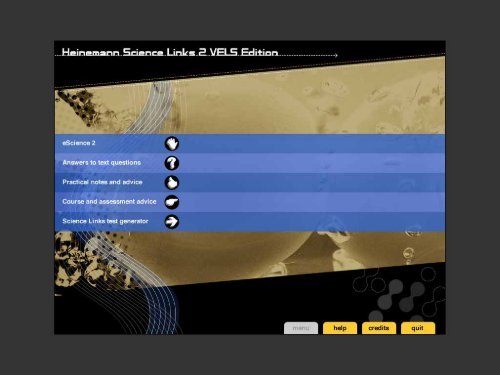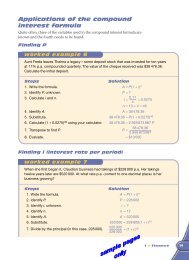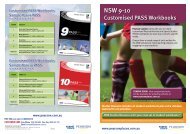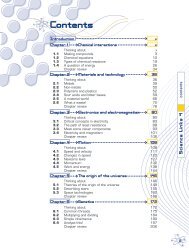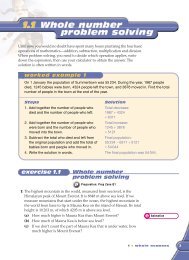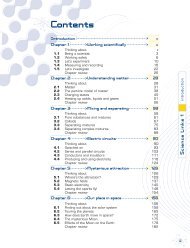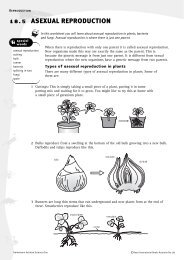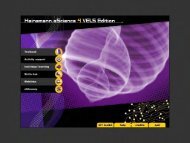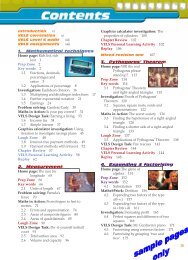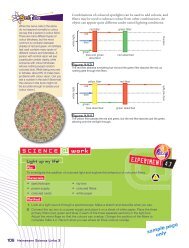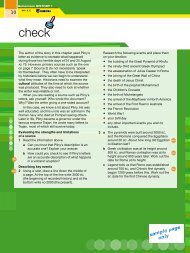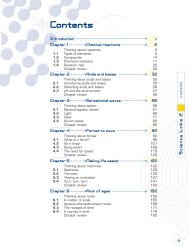Screen shots from Heinemann Science Links 2 VELS Edition TRAD
Screen shots from Heinemann Science Links 2 VELS Edition TRAD
Screen shots from Heinemann Science Links 2 VELS Edition TRAD
You also want an ePaper? Increase the reach of your titles
YUMPU automatically turns print PDFs into web optimized ePapers that Google loves.
Answers to text questions<br />
Chapter 1 Chemical reactions<br />
1.1 TYPES OF ELEMENTS<br />
QUESTIONS<br />
1 Matter refers to everything in the universe that<br />
has mass (can be weighed) and volume (takes up<br />
space). All matter consists of atoms and is in the<br />
form of a solid, liquid or gas.<br />
2 Individual student response (song, rap, poem or<br />
drawing) required. Responses will vary but may<br />
include the following information:<br />
• Atoms are the building blocks of matter.<br />
• An element is a pure substance composed of only<br />
one type of atom; it cannot be broken down into<br />
simpler substances so the song, rap, poem or<br />
drawing should reflect this concept.<br />
Encourage feedback <strong>from</strong> peers after students<br />
have performed their song or poem etc.<br />
3 The symbols for elements are derived <strong>from</strong>:<br />
• The first one or two letters of the element’s<br />
name, e.g. carbon C and Calcium Ca<br />
• Their old Latin or German names, e.g. copper<br />
Cu (Latin: cuprum) and tungsten W (German:<br />
Wulfram)<br />
• The names of famous people or places,<br />
e.g. rutherfordium Rf and plutonium Pu.<br />
4 (a) Ca, Fe, N, C, Pb, O<br />
(b) Aluminium, gold, bromine, chlorine, copper,<br />
mercury, potassium, phosphorus, sulfur, zinc<br />
(c) Francium, californium and americium are<br />
possible answers.<br />
(d) Einsteinium, mendelevium, lawrencium are<br />
possible answers.<br />
(e) Metals: sodium; Non-metals: oxygen, carbon;<br />
Metalloids: germanium, silicon<br />
5 Individual student response (pamphlet) required.<br />
Refer to the collaborative learning section in the<br />
Skills link chapter and the <strong>VELS</strong> and <strong>Science</strong><br />
<strong>Links</strong> section of the <strong>TRAD</strong> for help with the<br />
presentation of information, including pamphlets.<br />
Responses will vary but may include the<br />
following information:<br />
• Metals are often shiny, malleable, ductile,<br />
usually solid at room temperature and good<br />
conductors of electricity and heat, e.g. copper.<br />
Some uses of metals include construction<br />
materials, water pipes, coins, containers and<br />
jewellery.<br />
• Non-metals that are solids at room<br />
temperature are brittle, non-malleable, poor<br />
conductors of electricity and cannot be drawn<br />
into wires (e.g. sulfur). Some non-metals are<br />
gases at room temperature (e.g. oxygen) and<br />
others are liquids (e.g. bromine). Some uses<br />
of non-metals include air balloons, explosives,<br />
fertilisers and plastics.<br />
• Metalloids have properties between those of<br />
metals and non-metals. They are shiny, brittle,<br />
and semi-conductors (e.g. silicon). Some uses<br />
of metalloids include communication,<br />
transistors, solar cells and computer chips.<br />
6 Some pure metals are too soft and possess<br />
insufficient strength for many engineering<br />
purposes. Alloys are combinations of two or more<br />
metals, or a metal and a non-metal, that have<br />
desirable properties, such as greater strength,<br />
hardness, lightness or resistance to corrosion.<br />
Stainless steel is iron mixed with nickel and<br />
chromium. It is strong and resistant to rusting,<br />
therefore, it has a wide variety of uses.<br />
7 Melting point, boiling point, malleability,<br />
hardness, ductility, conductivity, magnetic<br />
properties. Students should be able to describe<br />
what each property means.<br />
8 Malleability refers to the property of a metal that<br />
makes it capable of being hammered or rolled<br />
into shape (e.g. sheet metal) whereas ductility<br />
refers to the ability of a metal to be drawn into<br />
wires (e.g. power lines).<br />
9 Individual student response (mind map) required.<br />
For help with mind maps refer to the Graphic<br />
organisers information in the <strong>VELS</strong> and <strong>Science</strong><br />
<strong>Links</strong> section of the <strong>TRAD</strong>. Responses will vary<br />
but may include the following information about<br />
the physical and chemical properties of graphite<br />
and diamond, as well as their sources and uses:<br />
• Carbon exists in several forms: diamond and<br />
graphite are two crystalline forms of carbon.<br />
• Diamond is the hardest natural substance<br />
known. In the diamond crystal, each carbon<br />
atom is linked tetrahedrally to four others.<br />
Transparent diamonds are valuable<br />
gemstones. Heavily coloured forms are used<br />
for rock drills, lathe tools and for cutting and<br />
polishing clear diamonds.<br />
• Graphite consists of parallel hexagonal sheets<br />
of carbon atoms. It is used in pencils,<br />
electrical components, paints and as a<br />
lubricant.<br />
• Most non-metals usually don’t conduct heat<br />
or electricity, but carbon is an exception. In<br />
graphite, the carbon atoms are bonded in<br />
sheets. Each carbon atom is bonded to three<br />
other carbon atoms, forming covalent bonds.<br />
The fourth electron of each carbon atom is<br />
mobile across the sheet of carbon atoms,<br />
forming an ‘electron sea’, which accounts for<br />
the electrical conductivity of graphite.<br />
<strong>Heinemann</strong> <strong>Science</strong> <strong>Links</strong> 2 <strong>TRAD</strong> Answers to text questions 2
Laboratory safety and practical advice<br />
The following information is provided to assist teachers in assessing and reducing the safety risk of each<br />
experiment. Any assessment of safety risk will need to take into account the circumstances under which the<br />
experiment is conducted, including the students’ abilities and the teacher’s experience.<br />
While every care has been taken in compiling this advice, no guarantee can be given against errors or<br />
incompleteness, or that regulations and standards will not change. Teachers are encouraged to become<br />
familiar with the regulations relating to dangerous goods and hazardous substances and to refer to the MSDS<br />
supplied by the manufacturer before using any chemical in an experiment.<br />
Designated hazardous substances are listed in bold. Dangerous goods are listed in italics. In some cases there<br />
are no special risk control measures—the activity is not considered hazardous as long as correct procedures<br />
are followed. This is indicated by RPP in the table. Rules, precautions and procedures (RPP) should be<br />
established to minimise risk. Teachers should establish these rules, precautions and procedures and revise<br />
them as necessary. Some of these are:<br />
• the correct procedure for lighting and using a Bunsen burner, and safety precautions such as tying<br />
back long hair, wearing suitable clothing (low flammability, no trailing sleeves) and footwear;<br />
• care in handling fragile glassware—for example, placing empty test-tubes in racks so they will not<br />
roll off the bench, etc.;<br />
• safe use of the mains power supply—for example, operating switches with dry hands, not turning<br />
switches on until instructed by the teacher, and inserting and removing plugs only when the switch is<br />
turned off;<br />
• the taping shut of exposed agar plates, and never opening them;<br />
• the correct way to deal with chemical spills;<br />
• the use of spatulas, etc. to transfer chemicals;<br />
• the correct way to mix chemicals in a test-tube—by gentle swirling rather than placing fingers or<br />
thumb over the mouth of the tube and shaking; and<br />
• the correct way to smell gases—by wafting with the hand rather than sniffing directly.<br />
<strong>Heinemann</strong> <strong>Science</strong> <strong>Links</strong> <strong>VELS</strong> 2 <strong>TRAD</strong> Laboratory safety and practical advice 1
HAZARDS AND SAFETY PRECAUTIONS<br />
Experiment/activity Hazard Safety advice Practical notes/hints<br />
Activity 1.1<br />
Investigating elements<br />
Fragile glassware (if glass<br />
sample bottles used)<br />
Calcium, magnesium and<br />
sulfur are dangerous<br />
substances.<br />
Iodine is a designated<br />
hazardous substance.<br />
RPP<br />
Reinforce warning not to<br />
open bottles.<br />
Be aware of the location of<br />
the MSDS and spill kits in<br />
case of breakages.<br />
Inspect for chips and<br />
cracks.<br />
Refer students to the Skills<br />
link chapter for help with<br />
using graphic organisers<br />
and a range of presentation<br />
formats.<br />
Experiment 1.3<br />
Hot water<br />
RPP<br />
Properties of elements<br />
Hammer<br />
Sulfur is a dangerous<br />
substance. It is easily<br />
ignited and an irritant to<br />
the respiratory system.<br />
Zinc is harmful by<br />
swallowing, inhalation and<br />
contact with skin, irritating<br />
to eyes and skin, risk of<br />
damage to eyes.<br />
Copper is harmful by<br />
inhalation and swallowing.<br />
Safety glasses must be<br />
worn when polishing and<br />
hammering samples.<br />
Disposable gloves should<br />
be worn when handling<br />
chemicals, and hands<br />
washed at the conclusion of<br />
the experiment.<br />
Warn against hitting<br />
fingers with hammer and<br />
inhaling dust when<br />
polishing samples.<br />
Lead is a designated<br />
hazardous substance. It is<br />
harmful by inhalation and<br />
swallowing, irritant to eyes.<br />
Experiment 1.4<br />
What’s in a compound<br />
Fragile glassware<br />
Hydrochloric acid is a<br />
designated hazardous<br />
substance, corrosive,<br />
causes burns, harmful by<br />
inhalation at concentrations<br />
equal to or more than<br />
0.2%, irritating to eyes,<br />
respiratory system and skin<br />
at concentrations equal to<br />
or more than 0.02% and<br />
less than 0.2%.<br />
RPP<br />
Reinforce instructions not<br />
to touch chemicals. Advise<br />
students of procedures if<br />
chemicals are accidentally<br />
spilled.<br />
Use dilute hydrochloric<br />
acid (0.1 M).<br />
RPP<br />
Safety glasses should be<br />
worn. Make sure that only<br />
the specified quantities of<br />
reactants are used.<br />
Emphasise care to avoid<br />
spills. If reagents are<br />
spilled on skin, rinse with<br />
copious amounts of water.<br />
Refer students to the Skills<br />
link chapter for help with<br />
using a range of<br />
presentation formats.<br />
<strong>Heinemann</strong> <strong>Science</strong> <strong>Links</strong> <strong>VELS</strong> 2 <strong>TRAD</strong> Laboratory safety and practical advice 2


